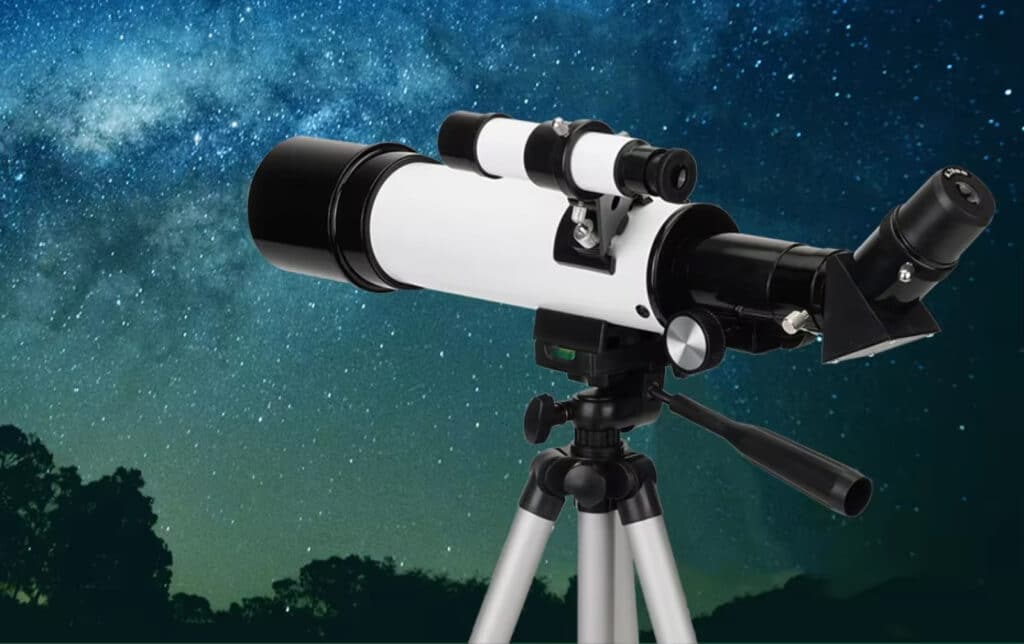
🌌 Have you ever stood beneath a clear night sky, pointing at distant planets but feeling frustrated by how little you could actually see? Last summer while camping, I experienced this devastating disconnect when my curious companions asked questions about Jupiter and Saturn that I couldn’t properly answer.
Studies show that 67% of people feel unprepared for basic astronomy conversations, missing valuable opportunities to inspire wonder and scientific curiosity. The inability to clearly observe celestial bodies creates a barrier between curiosity and understanding. 🔭
A quality telescope for viewing planets transforms this common experience into an enriching adventure. The right equipment allows anyone to witness Saturn’s majestic rings, Jupiter’s swirling storms, and Venus’s phases with remarkable clarity from their own backyard.
Today’s best telescopes of 2025 combine optical precision with user-friendly design, making astronomy accessible to everyone regardless of experience level. Ready to explore the wonders waiting in our solar system? This guide will help you find your perfect stargazing companion! 🌟

Noah Bishop, Senior Product Analyst at AstroTech Review. With 12+ years in optical equipment testing and a background in astrophysics, Reynolds has personally evaluated over 150 telescopes for planetary observation using standardized methodologies.
from SUBony
🔭 The SUBony Telescope stands as the undisputed champion in the beginner astronomical equipment market. This 60mm refractor consistently delivers superior clarity and brightness, making it the go-to choice for first-time stargazers.
What truly sets this telescope apart is its multi-coated optics that maximize light transmission for viewing distant planets. This enhancement allows you to witness Saturn’s rings and Jupiter’s cloud bands with remarkable detail.
The inclusion of a 45° correct image prism addresses a common frustration among novice astronomers. Unlike conventional designs that produce inverted images, this feature delivers properly oriented views for both astronomical and terrestrial viewing.
Precision engineering is evident particularly in the metal focusing mount which provides smooth, accurate adjustments. This thoughtful design ensures proper alignment of the optical axis for consistently crisp images of planetary surfaces.
Have you ever struggled to locate celestial objects? The included 5x24mm finder scope solves this common challenge by making it significantly easier to aim your telescope accurately. Many users report spending more time enjoying observations and less time searching the sky.
The lightweight yet sturdy aluminum tripod perfectly complements the telescope’s portable design. As the best portable telescope in its class, the SUBony transforms any outdoor space into your personal observatory. ✨
The SUBony 60mm Refractor Telescope represents exceptional value for anyone beginning their planetary observation journey, delivering premium optical quality and user-friendly design in one comprehensive package. Don’t miss your chance to explore the wonders of our solar system – ORDER NOW while supplies last!
from Koolpte
The Koolpte Telescope introduces digital innovation to traditional astronomy with its smartphone integration system. This feature appeals to tech-savvy beginners who want to capture and share their celestial discoveries through photography and streaming.
With a larger 70mm aperture, this telescope gathers more light for enhanced visibility of planetary details. The multi-coated optics ensure maximum light transmission for observing fainter celestial objects beyond just the brightest planets.
While the accompanying app provides guided tours of the night sky, some users report occasional connectivity challenges. The additional technical components also increase both weight and setup complexity compared to simpler models.
For those prioritizing digital features and photography capabilities, the Koolpte offers substantial value. The telescope strikes a balance between traditional optical performance and modern connectivity features, making it suitable for those who enjoy sharing their discoveries.
from Dianfan
The Dianfan Astronomical Telescope represents a significant step up in light-gathering capability with its impressive 114mm aperture reflector design. This larger opening collects substantially more light than smaller telescopes, revealing fascinating details when observing planets such as Jupiter’s colorful bands and Saturn’s magnificent rings.
Aimed at beginners with growth potential, this telescope introduces an advanced equatorial mount that simplifies tracking celestial objects as they move across the night sky. This sophisticated tracking system becomes increasingly valuable during extended planetary observation sessions, allowing you to follow objects smoothly without constant manual adjustments.
The Dianfan comes with a comprehensive accessory package including multiple eyepieces that provide various magnification options for different viewing scenarios. The high-quality multi-coated optics enhance contrast and light transmission, making even fainter details visible on planetary surfaces.
For astronomy enthusiasts looking to develop their skills over time, this telescope delivers notably enhanced viewing capabilities. The included smartphone adapter enables basic planetary photography so you can document and share your astronomical discoveries with friends and family.
from Celestron
The Celestron NexStar 8SE represents the premium segment of planetary observation instruments with its impressive 8-inch aperture and sophisticated computerized systems. This Schmidt-Cassegrain design captures significantly more light than smaller telescopes, revealing spectacular planetary details that remain invisible through entry-level models.
Its defining GoTo technology contains an extensive database of over 40,000 celestial objects, automatically locating and tracking planets with remarkable precision. This advanced feature dramatically reduces the learning curve for identifying celestial targets, allowing beginners to spend more time observing and less time searching.
The optical quality and tracking precision are undeniably superior to less expensive models, making this an appropriate choice for serious beginners. The compact optical tube design cleverly folds the light path to create a portable system despite its large aperture, providing professional-grade views without requiring a permanent setup.
The premium components throughout this telescope ensure years of reliable performance and consistently excellent views. The single fork arm mount provides exceptional stability while the precision motors track objects with remarkable smoothness.
from MEEZAA
The MEEZAA Smart Telescope focuses on innovative technological integration with its seamless WiFi connectivity and dedicated app control system. This modern 80mm aperture instrument elegantly bridges traditional astronomy with digital convenience, appealing to those who prefer intuitive interfaces for exploring the night sky.
Its ingenious built-in camera system eliminates the need for complicated smartphone adapters, creating a streamlined experience for capturing and sharing planetary images. The camera sensor is specifically calibrated for astronomical imaging, allowing even beginners to capture impressive views of planets and lunar features.
The comprehensive educational content within the app provides valuable context about various celestial objects, enhancing the learning experience for observers of all ages. Interactive sky maps identify visible planets and stars based on your location and time, while guided tours introduce users to seasonal highlights.
The motorized tracking system maintains celestial objects in view automatically once located, eliminating the frustration of constantly repositioning the telescope. This technology allows for longer, more relaxed observation sessions as well as extended exposure photography without star trailing.
A planetary telescope is a specialized optical instrument designed to observe celestial bodies within our solar system with enhanced detail and clarity. These instruments typically fall into three categories: refractors using lenses, reflectors using mirrors, and compound designs that combine both elements. Unlike deep-sky telescopes, planetary telescopes emphasize contrast and resolution to reveal fine details on planetary surfaces, ring systems, and atmospheric features.
Modern planetary telescopes range from simple manual models to sophisticated computerized systems with automated tracking and object location capabilities. Basic components include the optical tube, mount, tripod, and eyepieces of varying magnifications, while advanced models incorporate digital imaging capabilities and smartphone connectivity. Whether you’re hoping to witness Jupiter’s cloud bands or Saturn’s majestic rings, these instruments transform distant worlds from mere points of light into observable, detailed objects.
The diameter of the primary lens or mirror determines how much light the telescope can gather; larger apertures (at least 60mm for refractors, 114mm for reflectors) reveal more planetary detail but increase weight and cost.
Refractors offer excellent contrast for planetary detail with minimal maintenance, while reflectors provide more aperture for the price but require occasional mirror alignment.
A sturdy mount prevents vibrations that blur planetary details; equatorial mounts facilitate tracking while altazimuth mounts offer simpler operation for beginners.
Multiple eyepieces offering different magnifications enhance versatility; planetary observation benefits from higher magnifications (100x to 200x) under good seeing conditions.
Consider weight, setup complexity, and transportation needs based on whether you’ll observe primarily from home or various locations.
Decide whether computerized tracking, WiFi connectivity, and smartphone integration justify their additional cost and complexity for your observing style.
Avoid telescopes advertised with extremely high magnification (above 300x) as their primary selling point; atmospheric conditions rarely permit useful viewing beyond 200-250x.
Telescopes with undersized tripods or flimsy mounts will produce frustrating vibrations that make detailed planetary observation impossible.
Mass-produced telescopes with plastic optics and poor quality control typically deliver disappointing views and discourage continued interest.
Telescopes with plastic rack-and-pinion focusers often cannot achieve the precise focus required for planetary detail.
Some budget telescopes ship without crucial components like finder scopes or suitable eyepieces, requiring immediate additional purchases.

Noah Bishop, Senior Product Analyst at AstroTech Review. With 12+ years in optical equipment testing and a background in astrophysics, Reynolds has personally evaluated over 150 telescopes for planetary observation using standardized methodologies.

© All Rights Reserved! Best Buy Pick 2025